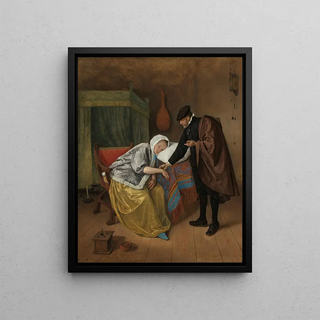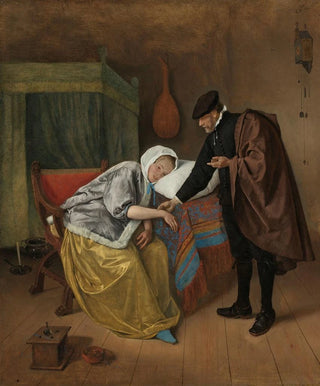Art print | The Sick Woman - Jan Steen


View from behind

Frame (optional)
In the vibrant world of 17th-century Dutch painting, the art print "La femme malade" by Jan Steen stands out for its simultaneously intimate and social approach. This canvas, depicting a domestic scene filled with realism, invites the viewer to enter a world where illness and daily life intertwine. The composition, rich in narrative details, evokes a moment of human vulnerability while revealing the complexity of social relationships of the time. The soft light bathing the scene enhances this atmosphere of tenderness and compassion, offering a poignant glimpse into the human condition.
Style and uniqueness of the work
Jan Steen's style is characterized by vivid chromaticity and an unparalleled mastery of movement. In "La femme malade," the artist uses warm colors to create a comforting ambiance, contrasting with the seriousness of illness. Each character is carefully placed, contributing to a visual storytelling that captures attention. The expressions on their faces, ranging from concern to care, demonstrate a meticulous observation of human nature. Steen, as a true narrator, manages to convey complex emotions through simple gestures and everyday interactions. The composition, which appears almost photographic in its precision, reminds us that every detail matters in constructing a story.
The artist and his influence
Jan Steen, born in 1626 in Leiden, is one of the masters of Dutch painting, recognized for his ability to capture everyday life with a touch of humor and social critique. His career, marked by a prolific production of works, reflects the values and concerns of his time. Steen knew how to establish himself as a keen observer of society, using his art to comment on morals and behaviors of his contemporaries. His influence endures, inspiring many artists who seek to explore themes of domestic life and human relationships. By incorporating elements of popular culture and genre scenes, he paved the way for a new way of perceiving painting, where daily life becomes a subject worthy of interest.
An exceptional wall decoration signed Artem Legrand
In the context of interior decoration, the art print

Matte finish

View from behind

Frame (optional)
In the vibrant world of 17th-century Dutch painting, the art print "La femme malade" by Jan Steen stands out for its simultaneously intimate and social approach. This canvas, depicting a domestic scene filled with realism, invites the viewer to enter a world where illness and daily life intertwine. The composition, rich in narrative details, evokes a moment of human vulnerability while revealing the complexity of social relationships of the time. The soft light bathing the scene enhances this atmosphere of tenderness and compassion, offering a poignant glimpse into the human condition.
Style and uniqueness of the work
Jan Steen's style is characterized by vivid chromaticity and an unparalleled mastery of movement. In "La femme malade," the artist uses warm colors to create a comforting ambiance, contrasting with the seriousness of illness. Each character is carefully placed, contributing to a visual storytelling that captures attention. The expressions on their faces, ranging from concern to care, demonstrate a meticulous observation of human nature. Steen, as a true narrator, manages to convey complex emotions through simple gestures and everyday interactions. The composition, which appears almost photographic in its precision, reminds us that every detail matters in constructing a story.
The artist and his influence
Jan Steen, born in 1626 in Leiden, is one of the masters of Dutch painting, recognized for his ability to capture everyday life with a touch of humor and social critique. His career, marked by a prolific production of works, reflects the values and concerns of his time. Steen knew how to establish himself as a keen observer of society, using his art to comment on morals and behaviors of his contemporaries. His influence endures, inspiring many artists who seek to explore themes of domestic life and human relationships. By incorporating elements of popular culture and genre scenes, he paved the way for a new way of perceiving painting, where daily life becomes a subject worthy of interest.
An exceptional wall decoration signed Artem Legrand
In the context of interior decoration, the art print






